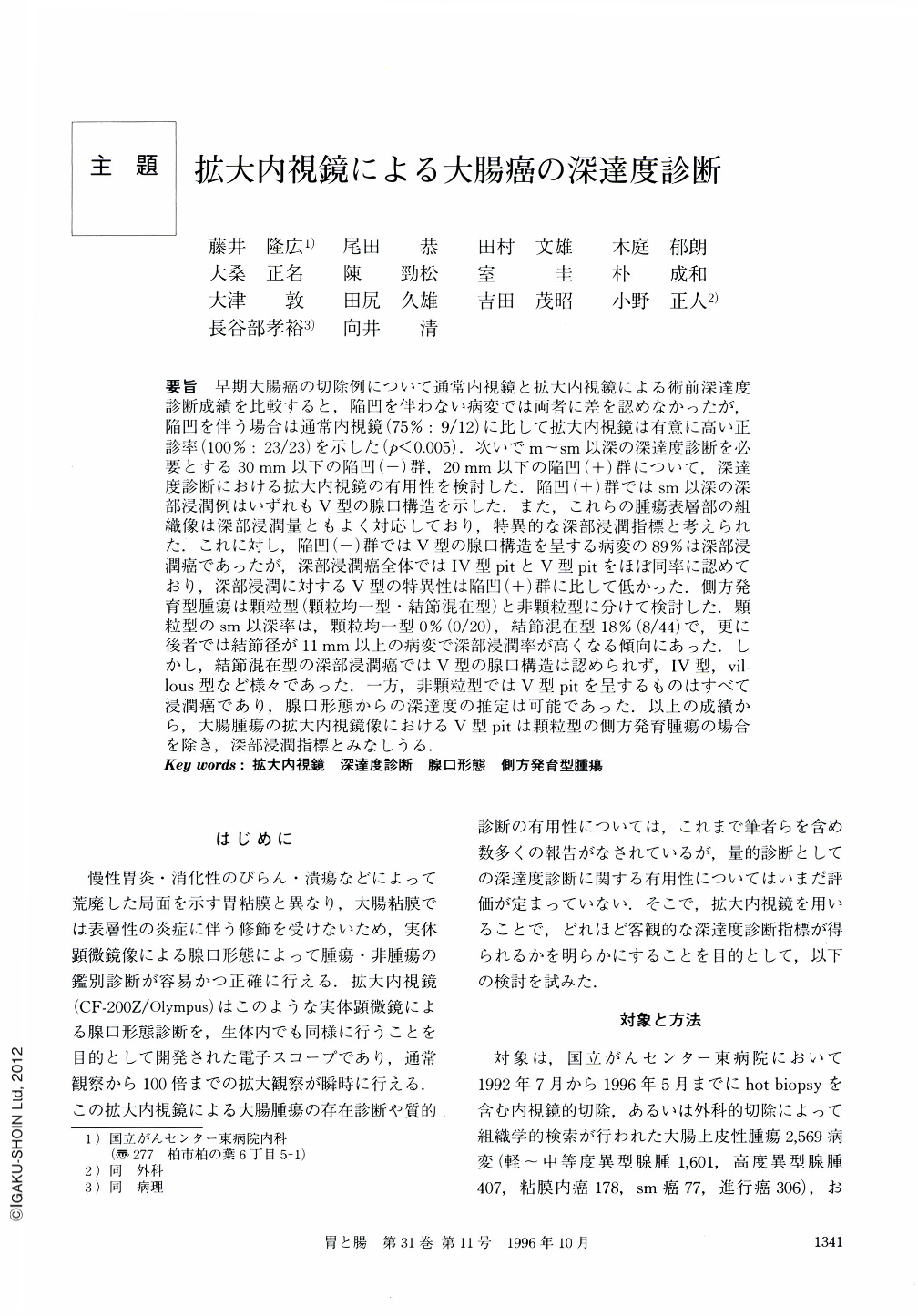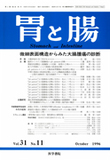Japanese
English
- 有料閲覧
- Abstract 文献概要
- 1ページ目 Look Inside
- サイト内被引用 Cited by
要旨 早期大腸癌の切除例について通常内視鏡と拡大内視鏡による術前深達度診断成績を比較すると,陥凹を伴わない病変では両者に差を認めなかったが,陥凹を伴う場合は通常内視鏡(75%:9/12)に比して拡大内視鏡は有意に高い正診率(100%:23/23)を示した(p<0.005).次いでm~sm以深の深達度診断を必要とする30mm以下の陥凹(-)群,20mm以下の陥凹(+)群について,深達度診断における拡大内視鏡の有用性を検討した.陥凹(+)群ではsm以深の深部浸潤例はいずれもⅤ型の腺口構造を示した.また,これらの腫瘍表層部の組織像は深部浸潤量ともよく対応しており,特異的な深部浸潤指標と考えられた.これに対し,陥凹(-)群ではⅤ型の腺口構造を呈する病変の89%は深部浸潤癌であったが,深部浸潤癌全体ではⅣ型pitとV型pitをほぼ同率に認めており,深部浸潤に対するV型の特異性は陥凹(+)群に比して低かった.側方発育型腫瘍は顆粒型(顆粒均一型・結節混在型)と非顆粒型に分けて検討した.顆粒型のsm以深率は,顆粒均一型0%(0/20),結節混在型18%(8/44)で,更に後者では結節径が11mm以上の病変で深部浸潤率が高くなる傾向にあった.しかし,結節混在型の深部浸潤癌ではⅤ型の腺口構造は認められず,Ⅳ型,villous型など様々であった.一方,非顆粒型ではⅤ型pitを呈するものはすべて浸潤癌であり,腺口形態からの深達度の推定は可能であった.以上の成績から,大腸腫瘍の拡大内視鏡像におけるⅤ型pitは顆粒型の側方発育腫瘍の場合を除き,深部浸潤指標とみなしうる.
We compared accuracy rate of preoperative diagnosis of the depth of invasion by ordinary endoscopic examination and that by magnifying endoscopic examination on the resected early colorectal cancers. There were no differences between accuracy rates by both examinations in the non-depressed lesions, but in the depressed lesions, magnifying endoscopic examination was significantly more accurate than ordinary endoscopic examination (accuracy rates: 100% (23/23) vs 75% (9/12), p<0.005). The non-depressed lesions less than 30 mm in size and the depressed lesions less than 20 mm in size with deeper than intramucosal and/or submucosal invasion were assessed for evaluating usefulness of magnifying endoscopic examination for diagnosis of depth of invasion. All the depressed lesions with deeper than submucosal invasion showed type Ⅴ pit pattern and histological feature of the tumor surface correlated to the amount of invasion and were regarded as a specific indicator of deep invasion. On the other hand, in the non-depressed lesions, although 89% of lesions with type Ⅴ pit pattern were accompanied by deep invasive cancer, in the group of deep invasive cancerous lesions the percentage of type Ⅴ pit pattern was the same as that of type Ⅳ pit pattern, therefore type Ⅴ pit pattern in the non-depressed lesions was not so specifically meaningful as that in the depressed lesions.
The laterally-spreading tumor was divided into the granular type (homogenous granular type and nodule intermingled type) and non-granular type. The rates of invasion deeper than submucosa in the granular type were as follows: 0% (0/20) in the homogenous granular type and 18% (8/44) in the nodule intermingled type. In the nodule intermingled type, when the nodule was more than, 11 mm in size, probability of deep invasion progressed with the size of nodule. But the nodule intermingled type with deep invasion did not show type Ⅴ pit pattern but showed various types including type Ⅳ or villous type. On the other hand, in the nongranular type, all lesions with type Ⅴ pit pattern were invasive cancer. As a result, type Ⅴ pit pattern of the colon tumor by magnifying endoscopic examination would suggest deep invasion except for the granular type of the laterally-spreading tumor.

Copyright © 1996, Igaku-Shoin Ltd. All rights reserved.


